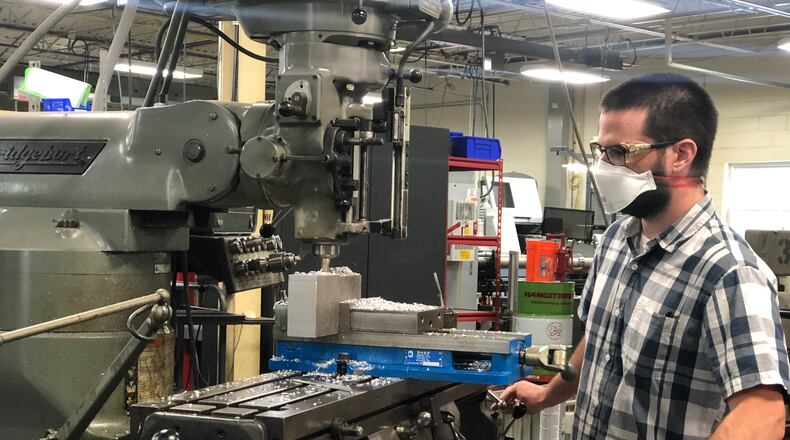While the recent job growth is encouraging, some deep economic scars remain, and most people have lost hope for a V-shaped recovery, in which the economy would instantly snap back when public health lockdown measures were eased or lifted.
Local employment remains about 29,000 jobs below pre-pandemic levels, and there are signs that more trouble lies ahead for the local labor market, including PSA Airlines’ announcement that it will lay off 229 workers this fall.
Dayton’s unemployment rate was 10.7% in June, down 2 percentage points from May.
“We’re in for a long recovery, but how long is still unknown since our businesses are still looking at a different consumer landscape today,” said Holly Allen, director of marketing and communications with the Dayton Area Chamber of Commerce.
Improvements in the job market
In June, employment in the Dayton metro area increased 2.8% to 361,600 jobs, according to preliminary and seasonally adjusted data from the bureau.
The job growth (+9,700 jobs) was the largest on record for the metro area, which consists of Montgomery, Miami and Greene counties. The bureau’s current system has records dating back to 1990.
The bureau also revised its job numbers for May, and local employment actually increased by 8,000 jobs that month, up from an original estimate of 6,200. That tied the previous record for one-month job growth, set in August 1998.
Despite the record job growth, the local job market still has a long way to climb to recoup April’s losses (-45,200 jobs).
Leisure and hospitality was one of the first industries impacted by COVID-19, and also it was one of the hardest hit. But last month, it saw the largest gains.
Local industry employment increased by 7,700 jobs to 36,100 workers, according to preliminary and not seasonally adjusted data. That’s up from a low of 25,500 jobs in April, when many bars and restaurants were closed or had extremely limited operations.
Employment still remains more than 2,000 jobs below pre-pandemic levels.
Drinking and eating establishments have tried to find creative ways to reopen safely and make customers feel comfortable. They have reduced capacity, added dividers and plastic shields and created new outdoor seating.
But many have not hired back all of their laid off workers, because of weak demand. Some businesses, like Corner Kitchen in the Oregon District, have closed for good because they were bleeding money.
Some companies are still cutting jobs, and others may have to in the near future. Dayton’s unemployment rate was 10.7% last month, down from 12.7% in May and 15.9% in April.
Different industries, different impact
COVID-19 hit different industries in very different ways, and consumer demand and service delivery methods have shifted, said Allen, with the Dayton Area Chamber of Commerce.
Changes in consumer demand have led to some job losses, but they also have created new opportunities, she said.
Overall, “in-demand” industries in the region have shown growth, such as manufacturing, construction, transportation and business services, she said.
“Consumers are ordering online, and when you couple that with pent-up demand and a shift in the way they purchase products, there’s more pressure on the transportation and logistics industry to deliver those products,” she said.
Manufacturing companies hired about 1,800 workers in June, after adding about 2,500 in May, according to not seasonally adjusted bureau data.
Manufacturers lost 4,700 jobs in April, which means employment last month was just 600 jobs short of its February level, according to not seasonally adjusted data.
Professional and business services employers added 1,100 jobs in June, after gaining 1,600 in May. The sector has gained back many of the 3,800 jobs it lost in April.
Some local businesses are hiring, like Auto-Valve Inc. (AVI), an aerospace manufacturing company in Dayton.
AVI has 62 employees, including 10 college interns, and 10 open positions are posted online, said Tim Claude, the company’s director and general manger.
AVI’s sales in the aerospace market dropped 25% during the COVID-19 crisis, but the company was able to retain all of its employees by cutting back their hours, from 55 hours per week to 40, he said.
Sales were slow to pick up, but AVI expects some new contracts to be released soon, and the company is looking to fill positions ranging from managers to engineers to shop floor machinists and assemblers, Claude said.
AVI has seen an increase in job applications, but the challenge is finding experienced workers, because most applicants have not worked in the industry, Claude said.
Some employers in key industries hit the pause button during the outbreak, but many quickly developed safety plans and have resumed normal operations, with some actually increasing staff and output, said Jeff Hoagland, president and CEO of the Dayton Development Coalition.
Hoagland pointed out that Crocs recently announced that it is building a second distribution center in Dayton that is expected to hire 400 to 500 new employees.
Hoagland said this crisis is unlike any the region has faced in the last 100 years, but he’s very optimistic that Dayton and Ohio will find a way to overcome any challenges it presents.
“We see a bright future,” he said. “With the way we’ve positioned ourselves ... we’re poised to come out of it quicker than some of the other states and places around the country.”
About the Author


